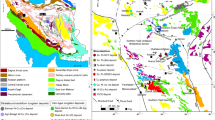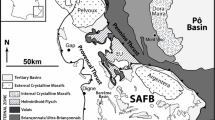Summary
Polymetallicmajor veins of the West Carbery district (County Cork) are compared with the nearby stratiform-disseminated copper mineralization in metasedimentary rocks, containingminor veins (metamorphic quartz veins and veinlets). These stratiform deposits are hosted by non-marine Devonian sediments (Old Red Sandstone), metamorphosed in the Hercynian orogeny. In sulphides from the stratiform deposits and minor veins, isotopic compositions of sulphur (δ34S) range from − 21.00 to + 5.14%0, consistent with the vein sulphide being remobilized stratiform-disseminated sulphide, and the latter being of diagenetic bacteriogenic origin. Sulphate (barite), found in veins separate from the sulphides, has δ34S + 12.3 to + 15.7%0. consistent with groundwater origin. In minor-vein quartz, fluid inclusions have homogenization temperatures consistent with trapping under the estimated peak-metamorphic conditions (300–400°C, 1–3 kbar).
In the major veins, sulphide δ34S (−15.8 to −4.2 0) suggest remobilization of diagenetic sulphide. Oxygen and hydrogen isotopes suggest deposition from metamorphic fluids (calculated δ18OH2O approximately + 8 to + l3%0, measured range of δD −52.2 to −27.3%0). Immiscible C02-bearing fluids were trapped in the temperature range 280–350°C with fluid pressure < ca. 600 bar. The inferred pressure-temperature history is attributed to late-metamorphic uplift, with fluid pressures falling below lithostatic. The sulphide-bearing veins are interpreted as a small-scale example of redistribution of mineral deposits by metamorphic fluids.
Zusammenfassung
Polymetallische Erzgänge (“major veins“) des westlichen Carbery Distriktes (County Cork) werden mit kleineren Gängchen (“minor veins”), die in den benachbarten, eine disseminierte stratiforme Cu-Vererzung führenden, Metasedimenten liegen, verglichen. Diese stratiformen Lagerstätten sind an nichtmarine devonische Sedimente (Old Red Sandstone), die während der hercynischen Orogenese metamorphisiert wurden, gebunden. Die Zusammensetzung der Schwefelisotope (δ34S) der Sulfide in der disseminierten Vererzung und in den kleineren Gängen variiert von −21.00 bis −5.14%0. Diese Zusammensetzung ist mit der Interpretation, daß der Schwefel in den Gängchen aus den stratiformen disseminierten Sulfiden remobilisiert wurde, die ihrerseits diagenetischbakteriogene Signatur zeigen, konsistent: Die δ345-Werte der Sulfate (Baryt) in den Gängchen variieren von + 12.3 bis + 15.7%0, was mit einer Herkunft aus Grundwässern übereinstimmt. Die Homogenisierungs-Temperaturen der FlüsBigkeitseinschlüsse in Quarz der Gängchen sind mit einem Einschluß der Fluide während des Höhepunktes der Metamorphose (300–400°C, l-3 kbar) konsistent.
In den polymetallischen Erzgängen weisen die δ34S-Werte (−15.8 bis −4.2%0) auf die Remobilisation diagenetischen Schwefels, die Sauerstoff und Wasserstoffisotope auf Ausfällung aus metamorphen Wässern hin. Die berechneten δ18O-Werte liegen zwischen ca. +8 bis +13%0 die gemessenen δH-Werte zwischen −52.2 bis −27.3%0. Nicht mischbare C02-führende Fluide wurden im Temperaturbereich von 280–350°C bei Fluid-Drucken < ca. 600 bar eingeschlossen. Der abgeleitete P-T Pfad wird mit spätmetamorpher Hebung, während der der Fluiddruck unter den lithostatischen Druck fiel, erklärt. Die Sulfid-führenden Gänge werden als kleinmaßstäbliche Beispiele für Wiederverteilung von Minerallagerstätten durch metamorphe Fluide gedeutet.
Similar content being viewed by others
References
Bowers TS, Helgeson HC (1983) Calculation of the thermodynamic and geochemical consequences of nonideal mixing in the system H2O-CO2-NaCl on phase relations in geologic systems: metamorphic equilibria at high pressures and temperatures. Am Mineral 68: 1059–1075
Claypool GE, Holser WT, Kaplan IR, Sakai H, Zak I (1980) The age curves of sulfur and oxygen isotopes in marine sulfate and their mutual interpretation. Chem Geol 28: 199–260
Coe K, Selwood EB (1964) Some features of folding and faulting in the Sheeps Head Peninsula, Co. Cork, Ireland. Sci Proc R Dublin Soc, Series A 2: 29–41
Crawford ML, Hollister LS (1986) Metamorphic fluids: the evidence from fluid inclusions. In:Walther JV;Wood BJ (eds) Fluid-rock interactions during metamorphism. Springer, Berlin Heidelberg New York Tokyo, pp 1–35
Daltry VDC (1985) A structural, geochemical and mineralogical appraisal of the stratabound ore deposits in western County Cork, Ireland. Thesis, University College Cardiff, Wales
Evans AM (1976) Genesis of Irish base-metal deposits. In:Wolf KH (ed) Handbook of stratabound and stratiform ore deposits, vol 5. Elsevier, Amsterdam, pp 231–255
Fallick AE, Jocelyn J, Hamilton PJ (1987) Oxygen and hydrogen stable isotope systematics in Brazilian agates. In:Rodriguez Clemente E (ed) Geochemistry of the earth surface and processes of mineral formation. Instituto de Geologia (CSIC), Madrid, pp 99–117
Goldfarb RJ, Snee LW, Pickthorn WJ (1993) Orogenesis, high-T thermal events, and gold vein formation within metamorphic rocks of the Alaskan Cordillera. Mineral Mag 57: 375–394
Hall AJ, Boyce AJ, Fallick AE, Hamilton PJ (1991) Isotopic evidence of the depositional environment of Late Proterozoic stratiform barite mineralisation, Aberfeldy, Scotland. Chem Geol (Isotope Geosci Sect) 87: 99–114
Halliday AN, Mitchell JG (1983) K-Ar ages of clay concentrates from Irish orebodies and their bearing on the timing of mineralisation. Trans R Soc Edinburgh Scotland. Earth Sci 74: l-14
Haynes FM, Schrijver K (1989) Fluid-inclusion evidence of copper remobilization during retrograde metamorphism in the central Labrador Trough. Can Mineral 27: 23–40
Hemley JJ, Hunt JP (1992) Hydrothermal ore-forming processes in the light of studies in rock-buffered systems. II. Some general geologic applications. Econ Geol 87: 23–43
Ixer RA (1994) The study of mine 3/4 -ore mineralogy, Mount Gabriel. In:O'Brien W, Mount Gabriel, Bronze Age mining in Ireland. Galway University Press, Galway, pp 253–263
Jenkin GRT, Craw D, Fallick AE (1994) Stable isotopic and fluid inclusion evidence for meteoric fluid penetration into an active mountain belt; Alpine Schist, New Zealand. J Metamorph Geol 12: 429–444
Matsuhisa Y, Goldsmith JR, Clayton RN (1979) Oxygen isotopic fractionation in the system quartz-albite-anorthite-water. Geochim Cosmochim Acta 43: 1131–1140
Meere PA (1995) Sub-greenschist facies metamorphism from the Variscides of SW Ireland: an early syn-extensional peak thermal event. J Geol Soc London 152: 511–521
Nesbitt BE (1991) Phanerozoic gold deposits in tectonically active continental margins. In:Foster RP (ed) Gold metallogeny and exploration. Blackie, Glasgow, pp 104–132
Ni Wen (1991) Copper and other mineralization in metamorphosed ”red beds”, West Carbery area, south-west Cork, Ireland. Thesis, University of Birmingham
Nriagu JO, Rees CE, Mekhtiyeva VL, Lein AY, Fritz P, Drimmie RJ, Pankina RG, Robinson RW, Krouse HR (1991) Hydrosphere. In:Krouse HR, Grinenko VA (eds) Stable isotopes: natural and anthropogenic sulphur in the environment. Wiley, Chichester, pp 177–265
Ohmoto H (1986) Stable isotope geochemistry of ore deposits. Rev Mineral 16: 491–559
——Rye RO (1979) Isotopes of sulfur and carbon. In:Barnes HL (ed) Geochemistry of hydrothermal ore deposits, 2nd edn. Wiley, New York, pp 509–567
Pohl W (1992) Defining metamorphogenic mineral deposits -an introduction. Mineral Petrol 45: 145–152
Reilly TA (1986) A review of vein mineralization in S W County Cork, Ireland. In:Andrew CJ, Crowe RWA, Finlay S, Pennell WM, Pyne JF (eds) Geology and genesis of mineral deposits in Ireland. Irish Association for Economic Geology, Dublin, pp 513–544
Richards JP, Krogh TE, Spooner ETC (1988a) Fluid inclusion characteristics and U-Pb rutile age of late hydrothermal alteration and veining at the Musoshi stratiform copper deposit, Central African copper belt, Zaire. Econ Geol 83: 118–139
——Cumming GL, Krstic D, Wagner PA, Spooner ETC (1988b) Pb isotope constraints on the age of sulfide ore deposition and U-Pb age of late uraninite veining at the Musoshi stratiform copper deposit, Central African copper belt, Zaire. Econ Geol 83: 724–741
Sheppard SMF (1986) Characterization and isotopic variations in natural waters. Rev Mineral 16: 165–183
Snodin SR (1972) Copper and other mineralisation in the Upper Palaeozoic strata of south-west Cork, Ireland, and related areas. Thesis, University of Leicester
Sugaki A, Kitakaze A, Hayashi K (1984) Hydrothermal synthesis and phase relations of the polymetallic sulfide system, especially on the Cu-Fe-Bi-S system. In:Sunagawa I (ed) Materials science of the earth's interior. Terra Scientific Publishing Co, Tokyo, pp 545–583
Wilkinson JJ (1990) The role of metamorphic fluids in the development of the Cornubian orefield: fluid inclusion evidence from south Cornwall. Mineral Mag 54: 219–230
Author information
Authors and Affiliations
Additional information
With 6 Figures
Rights and permissions
About this article
Cite this article
Wen, N., Boyce, A.J., Fallick, A.E. et al. The genesis of Cu-bearing quartz veins by metamorphic remobilization from stratiform red bed deposits, SW County Cork, Ireland. Mineralogy and Petrology 57, 73–89 (1996). https://doi.org/10.1007/BF01161622
Received:
Accepted:
Issue Date:
DOI: https://doi.org/10.1007/BF01161622




